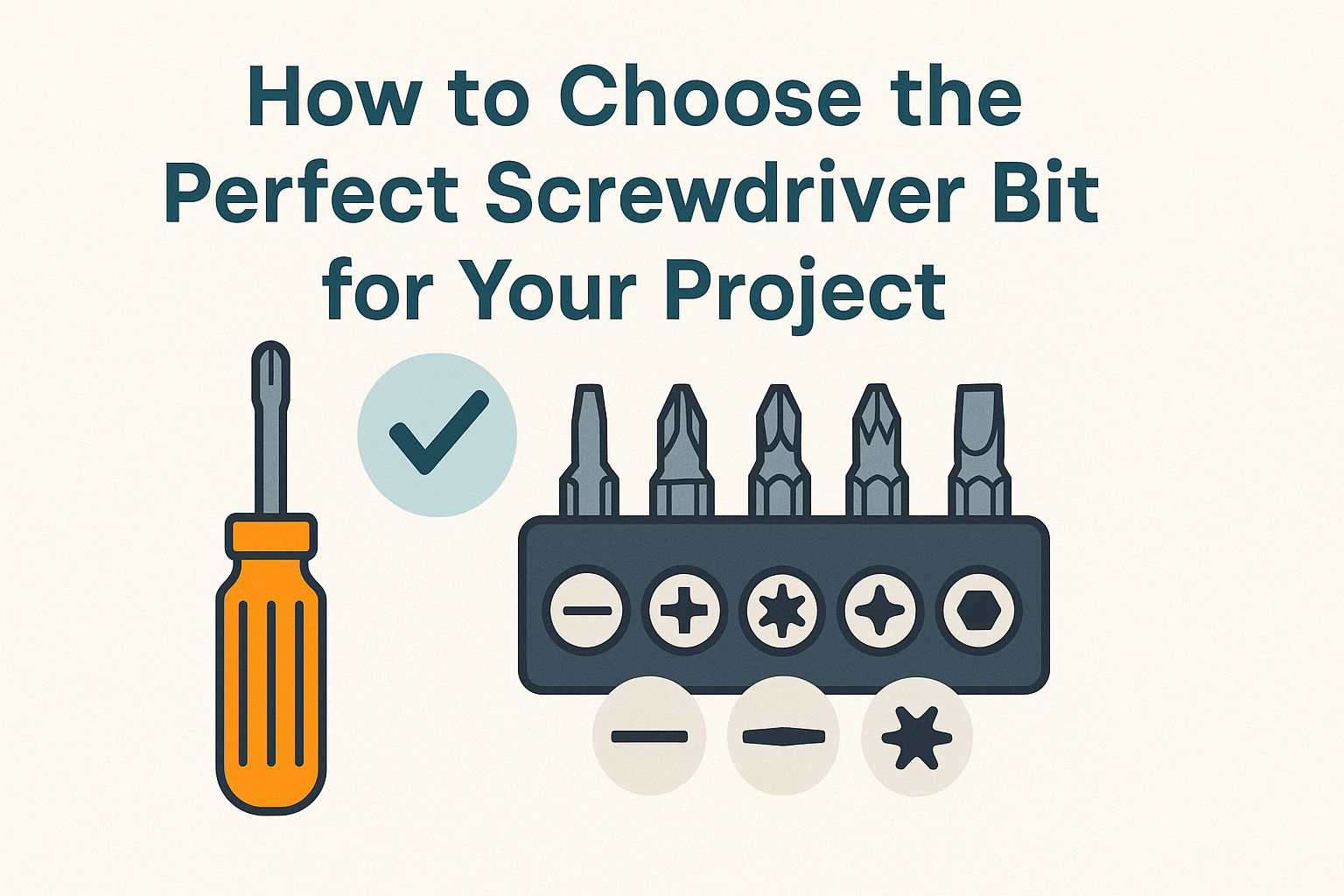How to Choose the Perfect Screwdriver Bit for Your Project

A Complete Guide:
When it comes to DIY projects, woodworking, or even simple home repairs, having the right screwdriver bit is crucial. Using the wrong bit can strip screws, damage materials, and make your job much harder than it needs to be. But with so many types and sizes available, how do you pick the perfect one?
In this guide, we’ll break down everything you need to know about screwdriver bits—types, materials, compatibility, and expert tips—so you can tackle any project with confidence.

Why Choosing the Right Screwdriver Bit Matters
Before diving into the different types, let’s understand why selecting the correct bit is so important:
- Prevents Stripped Screws – A mismatched bit can ruin screw heads, making removal difficult.
- Improves Efficiency – The right bit ensures a snug fit, allowing you to drive screws faster and with less effort.
- Enhances Safety – A slipping bit can cause injuries or damage your workpiece.
- Extends Tool Life – Using the correct bit reduces wear and tear on your drill or screwdriver.
Now, let’s explore the different types of screwdriver bits available.
Types of Screwdriver Bits
1. Phillips (PH)
Best for: General-purpose use, electronics, light construction.
Phillips bits (marked as PH) have a cross-shaped tip and are one of the most common types. They come in sizes PH0 (smallest) to PH4 (largest).
✅ Pros:
- Self-centering design.
- Widely available.
❌ Cons:
- Can cam out (slip) under high torque.
2. Flathead/Slotted (SL)
Best for: Older furniture, simple fastening tasks.
Flathead bits have a single flat edge and fit into straight screw slots. They come in various widths (e.g., 3mm, 6mm).
✅ Pros:
- Simple design.
- Easy to find.
❌ Cons:
- Prone to slipping.
- Not ideal for power tools.
3. Torx (Star) (T/TX)
Best for: Automotive, electronics, high-torque applications.
Torx bits have a six-point star shape, providing better grip and reducing cam-out. Sizes range from T1 to T100.
✅ Pros:
- High torque resistance.
- Less likely to strip screws.
❌ Cons:
- Less common in general hardware.
4. Hex (Allen) (H)
Best for: Furniture assembly, machinery, bikes.
Hex bits fit into hexagonal screw heads and come in metric (mm) and imperial (inches) sizes.
✅ Pros:
- Strong grip.
- Good for recessed screws.
❌ Cons:
- Can round off if not seated properly.
5. Pozidriv (PZ)
Best for: Construction, cabinetry.
Pozidriv looks like Phillips but has additional smaller ribs for better grip. Common sizes: PZ1, PZ2, PZ3.
✅ Pros:
- Reduced cam-out.
- Better for power tools.
❌ Cons:
- Often confused with Phillips, leading to improper use.
6. Robertson (Square) (SQ)
Best for: Woodworking, decking, Canadian-made products.
Robertson bits have a square recess and are popular in Canada. Sizes range from SQ0 to SQ5.
✅ Pros:
- Excellent grip.
- Minimal slipping.
❌ Cons:
- Less common in the U.S.
7. Security Bits (Tamper-Proof)
Best for: Public fixtures, electronics, restricted-access areas.
These specialized bits have unique shapes (e.g., Torx with a pin, Tri-wing, Spanner) to prevent tampering.
✅ Pros:
- Deters unauthorized access.
❌ Cons:
- Not widely available.
Choosing the Right Bit Material
The material of the bit affects durability and performance:
- Carbon Steel – Affordable but prone to wear.
- Chromium-Vanadium (Cr-V) – Stronger, resists wear better.
- S2 Tool Steel – High durability, best for heavy-duty use.
- Titanium-Coated – Reduces friction, extends lifespan.
Pro Tip: For frequent use, invest in high-quality S2 or titanium-coated bits.
Bit Size & Compatibility
Using the wrong size bit can damage screws. Here’s how to ensure a proper fit:
- Check Screw Head Markings (e.g., PH2, T25).
- Use a Bit Sizing Guide (available online or in hardware stores).
- Test Fit Before Driving – The bit should sit snugly without wobbling.
Magnetic vs. Non-Magnetic Bits
- Magnetic Bits – Hold screws in place, great for tight spaces.
- Non-Magnetic Bits – Necessary for electronics to avoid interference.
Impact Driver Bits vs. Standard Bits
- Standard Bits – For manual screwdrivers or light-duty drills.
- Impact Driver Bits – Made from hardened steel to withstand high torque.
Warning: Using standard bits in an impact driver can cause breakage.
How to Extend the Life of Your Bits
- Use the Right Bit for the Job – Avoid forcing mismatched bits.
- Apply Proper Pressure – Let the tool do the work.
- Keep Bits Clean – Wipe off debris after use.
- Store Properly – Use a bit organizer to prevent damage.
Final Tips for Choosing the Best Screwdriver Bit
✔ Match the Bit to the Screw Type – Check the head shape and size.
✔ Consider Material & Coating – Harder materials last longer.
✔ Use Impact Bits for High Torque – Prevents breakage.
✔ Invest in a Bit Set – Covers most common screw types.
Conclusion
Choosing the right screwdriver bit might seem like a small detail, but it makes a huge difference in the success of your project. Whether you’re assembling furniture, working on electronics, or tackling heavy construction, the correct bit ensures efficiency, safety, and professional results.
Now that you know how to pick the perfect bit, you’re ready to take on any screw-driving task with confidence!
Got a favorite screwdriver bit? Share your experiences in the comments below!
explore our Screwdriver Bits variety and also visit our store!